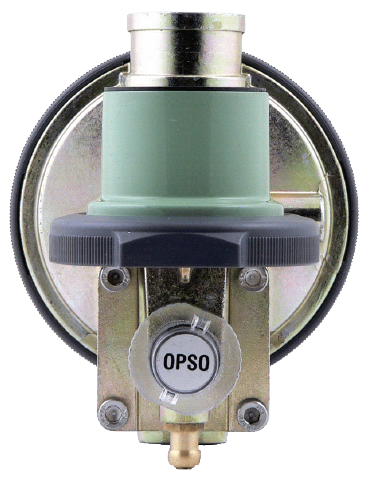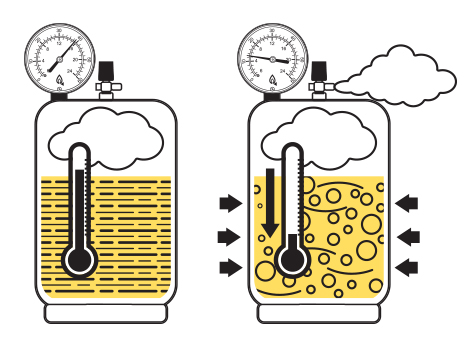What is LPG
 LPG is a gas in normal conditions but is stored in cylinders under pressure as a liquid. LPG is no longer limited to conventional petroleum-based sources. Renewable alternatives like Bio LPG and rDME (Renewable dimethyl ether) are already being utilized and tested. These renewable options offer a greener and sustainable approach to LPG production.
LPG is a gas in normal conditions but is stored in cylinders under pressure as a liquid. LPG is no longer limited to conventional petroleum-based sources. Renewable alternatives like Bio LPG and rDME (Renewable dimethyl ether) are already being utilized and tested. These renewable options offer a greener and sustainable approach to LPG production.
There are two basic types of LPG, Propane and Butane. The difference in their properties means that each is particularly suited to specific uses.
The chemical composition of Propane is C3H8, and Butane is C4H10. The larger Butane molecule gives both gases differing properties:
- Propane’s lower boiling point suits outdoor storage and is primarily used for central heating, cooking, and numerous commercial applications.
- Butane, on the other hand, doesn’t work in colder conditions and is best used indoors. It’s perfect for powering indoor portable heaters or used in warmer months for outdoor camping and cooking.
- Butane, having a larger molecule, when burnt in air dissipates more heat than propane.
LPG combustion produces fewer harmful emissions compared to other fuels. With its lower carbon content, LPG emits significantly fewer greenhouse gases, particulate matter, and sulphur dioxide, leading to cleaner air and reduced environmental impact.
LPG is compressed under pressure into portable cylinders or road tankers, which in turn fill static bulk tanks at point of use. When the gas is compressed, it easily changes to a liquid state, allowing a large amount of gas to be contained in a relatively small space. These storage and distribution methods enable efficient transport and minimize energy losses during the supply chain.
Likewise, the reverse process occurs when decompressed or allowed to escape the cylinder or pressure vessel. The liquid gas boils and quickly reverts to its gaseous state, so LPG is often called a vapour.
 Gas offtake decreases the gas pressure within the pressurised container, this pressure is regenerated by liquid vaporisation. The vaporisation needs energy from heat, and this is provided by the ambient air. This gives energy to the vessel to maintain the pressure, but the heat exchange is not perfect, as the temperature of the liquid starts to decrease, consequently the pressure decreases.
Gas offtake decreases the gas pressure within the pressurised container, this pressure is regenerated by liquid vaporisation. The vaporisation needs energy from heat, and this is provided by the ambient air. This gives energy to the vessel to maintain the pressure, but the heat exchange is not perfect, as the temperature of the liquid starts to decrease, consequently the pressure decreases.
Therefore, cylinders and bulk tanks have recommended offtake rates of vapour withdrawal to ensure that the ambient air is sufficient to heat the pressurised container, maintaining the required force to power the downstream gas appliances.
The larger the pressurised container, the greater the surface area in contact with the liquid LPG, and the more vapour can be generated.
When stored in a suitable pressurised tank or cylinder, LPG will remain liquid, occupying only a small space. Release some of the liquid and it will immediately boil and revert to its gaseous state, expanding as it does so. Liquid Propane expands to 250 times its liquid volume when reverting to gas. The reverse applies, as gaseous LPG will ‘shrink’ by 250 times when compressed and liquefaction takes place.
Inside the cylinder or tank the liquid is boiling, releasing vapour as it does so, just like boiling water releases steam, albeit at a much cooler temperature. Propane will do this right down to minus 42°C, which ensures that it will vaporise in all but the coldest climates and conditions.
Butane, however, will only vaporise readily from temperatures 0 – 2 °C, so when stored outdoors in the winter, appliances will need a propane supply. During warmer months, butane can also be utilized for outdoor activities like camping and cooking, providing a cleaner alternative to traditional fuel sources.
Commercial propane contains some butane, which occasionally remains as a liquid in containers during sustained cold weather conditions. Propane, having a lower boiling point, preferentially evaporates first. Only when the remaining butane liquid warms up will it start to produce pressure. This can sometimes be seen when an automatic changeover switches to reserve cylinder bank before all the contents has emptied normally in very cold weather conditions. However, once the cylinder has warmed, the residual butane will evaporate providing sufficient pressure to pass through the regulator to the appliances.
By choosing LPG as an alternative to traditional fossil fuels, individuals and businesses can play a part in mitigating climate change and promoting a greener and more sustainable future.




 LPG (Liquefied Petroleum Gas) contained in cylinders is supplied either as Butane or Propane. Commercial Butane contains approximately 80-90% Butane, whilst commercial Propane contains approximately 90% propane. The remainder will be made up of other hydrocarbons (Pentane, Hexane etc.) and the other LPG type (for example, Commercial Propane will contain an amount of Butane and vice versa).
LPG (Liquefied Petroleum Gas) contained in cylinders is supplied either as Butane or Propane. Commercial Butane contains approximately 80-90% Butane, whilst commercial Propane contains approximately 90% propane. The remainder will be made up of other hydrocarbons (Pentane, Hexane etc.) and the other LPG type (for example, Commercial Propane will contain an amount of Butane and vice versa). Maximum flow rate depends on:
Maximum flow rate depends on:
 When first installed select which cylinder(s) you want to be in service.
When first installed select which cylinder(s) you want to be in service.
 Underpressure Shutoff (UPSO)
Underpressure Shutoff (UPSO)